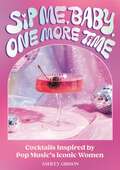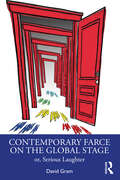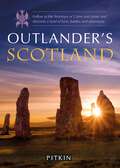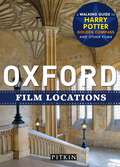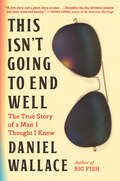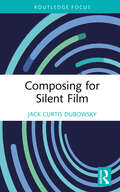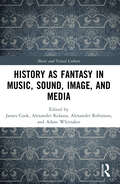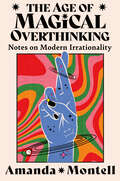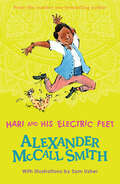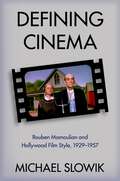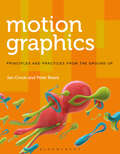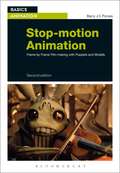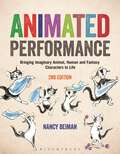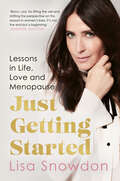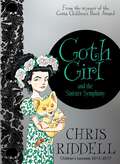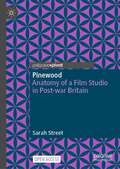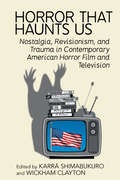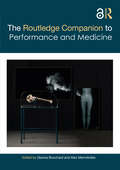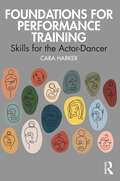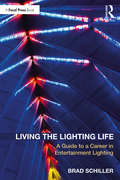- Table View
- List View
Sip Me, Baby, One More Time: Cocktails Inspired by Pop Music's Iconic Women
by Ashley GibsonMy thirstiness is killing me . . . As gorgeous as your favorite album art and as irresistible as a catchy hook, a collection of stunning (and stunningly easy) cocktail recipes based on pop songs by iconic women. With a great drink in your hand and the perfect song playing, you can transform any place into your own personal party. Pop music is unmatched when it comes to capturing a feeling, and this book is inspired by the great songs and women who define this genre, as well as some lesser-known artists whose music is as exciting as stumbling upon a new favorite liqueur that adds just the flavor you&’ve been missing.Sip Me, Baby, One More Time combines the art of cocktail making with the power of these artists to create an experience curated by emotion. Each chapter of this book is a journey through a playlist dedicated to a specific feeling—from coping with soul-crushing heartbreak to feeling like you want to hop on a table and dance it out—and is filled with easy to make, beautiful cocktails dedicated to tracks from top female artists.Featuring drinks inspired by songs from Britney Spears, Beyoncé, Taylor Swift, Rihanna, Ariana Grande, Lana Del Rey, BLACKPINK, The Spice Girls, Doja Cat, and many more.
Contemporary Farce on the Global Stage: or, Serious Laughter
by David GramContemporary Farce on the Global Stage provides audiences and practitioners a detailed survey of how the genre of farce has evolved in the 21st century. Often dismissed as frivolous, farce speaks a universal language, with the power to incisively interrogate our world through laughter.Unlike farces of the past, where a successful resolution was a given and we could laugh uproariously at adulterous behaviour, farce no longer guarantees an audience a happy ending where everything works out. Contemporary farce is no longer ‘diverting us’ with laughter. It is reflecting the fractured world around us. With a foreword by award-winning playwright Ken Ludwig, the book introduces readers to the Mechanics of Farce, and the ‘Four Ps,’ which are key elements for understanding, appreciating, and exploring the form. The Five Doors to Contemporary Farce identify five major categories into which farces fall. Behind each door are a wide selection of plays, modern and contemporary examples from all over the world, written by a diverse group of playwrights who traverse gender, race, ethnicity, and sexual orientation. Supplementing each section are comments, observations, and reflections from award-winning playwrights, directors, actors, designers, dramaturgs, and scholars.Designed specifically to give theatre-makers a rounded understanding that will underpin their own productions, this book will also be of use to theatre and performance studies students.
Outlander's Guide to Scotland (Location Guides #2)
by Phoebe Taplin'One of the best guide books ... all that you need to ensure a thoroughly enjoyable do-it-yourself Outlander tour.' – Outlander Home Page 'Beautifully presented ... and the print quality of the book is top-notch.' – Scottish Field 'Billow and breeze, islands and seas, Mountains of rain and sun...' Since 18th-century Highland warrior Jamie Fraser and resourceful 20th century medic, Claire Randall first met on screen in 2014, millions of viewers have been swept away by the Outlander TV series to the wild hills and craggy castles of Scotland. Now you can follow in the footsteps of Claire and Jamie with this guide to the inspiring locations where Diana Gabaldon's novels were set and the hit tv show were filmed. From the ancient cobbled streets, gabled palace and herb garden of Culross, which became fictional Cranesmuir, to the iconic 1960s Pathfoot Building at the University of Stirling, which Claire's daughter Brianna visits on her first trip to Scotland, you can time-travel through centuries. In Scotland, different eras coexist and collide – just as they do in Outlander. Focusing on easy day trips from the characterful cities of Edinburgh and Glasgow – themselves jam-packed with Outlander locations – this guide will tell you about the most rewarding sights, when to visit them and how to get there.
Oxford Film Locations (Location Guides #3)
by Phoebe TaplinHarry Potter, A Fish Called Wanda, Inspector Morse, Downton Abbey and X Men are just a few of the films that have become synonymous with the world renowned University City of Oxford. This new Pitkin souvenir guide highlights key sites that have become famously linked to these internationally successful and much loved films and TV specials. Not limited to Oxford city centre, this guide will also include the often-used film location Blenheim Palace, located just outside Oxford. With 15 individual Walks around Oxford, and information on both architecture and filming history, this guide will become a must-have souvenir for every visitor to Oxford.
This Isn't Going to End Well: The True Story of a Man I Thought I Knew
by Daniel WallaceIn this powerful memoir, the bestselling author of Big Fish tries to come to terms with the life and death of his multi-talented longtime friend and brother-in-law, who had been his biggest hero and inspiration, in a poignant, lyrical, and moving memoir. If we&’re lucky, we all encounter at least one person whose life elevates and inspires our own. For acclaimed novelist Daniel Wallace, he had one hero and inspiration for so much of what followed: his longtime friend and brother-in-law William Nealy. Seemingly perfect, impossibly cool, William was James Dean, Clint Eastwood, and MacGyver all rolled into one, an acclaimed outdoorsman, a famous cartoonist, an accomplished author, a master of all he undertook, William was the ideal that Daniel sought to emulate. But when William took his own life at age 48, Daniel was left first grieving, and then furious with the man who broke his and his sister&’s hearts. That anger led him to commit a grievous act of his own, a betrayal that took him down a dark path into the tortured recesses of William&’s past. Eventually, a new picture of William emerged, of a man with too many secrets and too much shame to bear. This Isn&’t Going to End Well is Daniel Wallace&’s first foray into nonfiction. Part love story, part true crime, part a desperate search for the self and how little we really can know another, This Isn&’t Going to End Well tells an intimate and moving story of what happens when we realize our heroes are human.
Composing for Silent Film
by Jack Curtis DubowskyComposing for Silent Film offers insight, information, and techniques for contemporary composition, arrangement, and live score performance for period silent film. A specialized music composition guide, this book complements existing film scoring and contemporary music composition texts. This book helps today’s composers better understand and correctly interpret period silent film, and to create and perform live scores that align with films’ original intentions, so that audiences notice and grasp fine points of the original film. Composing for Silent Film analyzes period silent film and its conventions – from Delsarte acting gestures to period fascinations and subtexts. As a practical composition text, it weighs varying approaches, including improvisation, through-scoring, "mickey-mousing," handling dialogue, and dividing roles amongst players. It steers composers towards informed understanding of silent film, and encourages them to deploy contemporary styles and techniques in exciting ways.For clarity and concision, examples are limited to nine canonical silents: Metropolis, Dr. Jekyll and Mr. Hyde, The Mark of Zorro, Sunrise: A Song of Two Humans, The Black Pirate, Nosferatu, The Phantom Carriage, Daisy Doodad’s Dial, and The Golem.
Composing for Silent Film
by Jack Curtis DubowskyComposing for Silent Film offers insight, information, and techniques for contemporary composition, arrangement, and live score performance for period silent film. A specialized music composition guide, this book complements existing film scoring and contemporary music composition texts. This book helps today’s composers better understand and correctly interpret period silent film, and to create and perform live scores that align with films’ original intentions, so that audiences notice and grasp fine points of the original film. Composing for Silent Film analyzes period silent film and its conventions – from Delsarte acting gestures to period fascinations and subtexts. As a practical composition text, it weighs varying approaches, including improvisation, through-scoring, "mickey-mousing," handling dialogue, and dividing roles amongst players. It steers composers towards informed understanding of silent film, and encourages them to deploy contemporary styles and techniques in exciting ways.For clarity and concision, examples are limited to nine canonical silents: Metropolis, Dr. Jekyll and Mr. Hyde, The Mark of Zorro, Sunrise: A Song of Two Humans, The Black Pirate, Nosferatu, The Phantom Carriage, Daisy Doodad’s Dial, and The Golem.
History as Fantasy in Music, Sound, Image, and Media (Music and Visual Culture)
by James Cook Alexander Kolassa Alexander Robinson Adam WhittakerExploring how music is used to portray the past in a variety of media, this book probes the relationship between history and fantasy in the imagination of the musical past. The volume brings together essays from multidisciplinary perspectives, addressing the use of music to convey a sense of the past in a wide range of multimedia contexts, including television, documentaries, opera, musical theatre, contemporary and historical film, videogames, and virtual reality. With a focus on early music and medievalism, the contributors theorise the role of music and sound in constructing ideas of the past. In three interrelated sections, the chapters problematise notions of historical authenticity on the stage and screen; theorise the future of musical histories in immersive and virtual media; and explore sound’s role in more fantastical appropriations of history in television and videogames. Together, they poseprovocative questions regarding our perceptions of ‘early’ music and the sensory experience of distant history. Offering new ways to understand the past at the crossroads of musical and visual culture, this collection is relevant to researchers across music, media, and historical and cultural studies.
History as Fantasy in Music, Sound, Image, and Media (Music and Visual Culture)
by James Cook, Alexander Kolassa, Alexander Robinson, and Adam WhittakerExploring how music is used to portray the past in a variety of media, this book probes the relationship between history and fantasy in the imagination of the musical past. The volume brings together essays from multidisciplinary perspectives, addressing the use of music to convey a sense of the past in a wide range of multimedia contexts, including television, documentaries, opera, musical theatre, contemporary and historical film, videogames, and virtual reality. With a focus on early music and medievalism, the contributors theorise the role of music and sound in constructing ideas of the past. In three interrelated sections, the chapters problematise notions of historical authenticity on the stage and screen; theorise the future of musical histories in immersive and virtual media; and explore sound’s role in more fantastical appropriations of history in television and videogames. Together, they poseprovocative questions regarding our perceptions of ‘early’ music and the sensory experience of distant history. Offering new ways to understand the past at the crossroads of musical and visual culture, this collection is relevant to researchers across music, media, and historical and cultural studies.
The Age of Magical Overthinking: Notes On Modern Irrationality
by Amanda MontellIn the modern information age, our brain’s coping mechanisms have been overloaded, and our irrationality turned up to eleven. Amanda Montell blends cultural criticism and personal narrative to explore our modern cognitive biases and the power, disadvantages and highlights of magical overthinking.
Conkers – Hari and His Electric Feet (Conkers)
by Alexander McCall SmithWith an authentic Indian backdrop, this is a feel-good story of young kids chasing big dreams that shimmers with all of Alexander McCall Smith’s trademark optimism and joy – an outlook on life that makes him one of the world’s best-loved storytellers.
Defining Cinema: Rouben Mamoulian and Hollywood Film Style, 1929-1957 (Oxford Music / Media)
by Michael SlowikArriving in cinema when synchronized sound had just been adopted, director Rouben Mamoulian demonstrated key early methods for making sound aid storytelling, for giving films a crisper sense of rhythm, for creating musicals set in backstage, fairy-tale, and folk environments, for providing intricate and arresting colour palettes, and for rendering sexual content more palpable under industry censorship. Mamoulian also wrote many articles throughout his lifetime and gave interviews and lectures where he advanced his complex ideas about the potentials of various artforms, including cinema. In addition, he left an extensive paper record of his work, including heavily annotated scripts for each of the sixteen films he directed. Mamoulian also enjoyed major success on the stage. He directed the original landmark productions of Porgy, Porgy and Bess, Oklahoma!, and Carousel, and his efforts in this domain informed his film work. Defining Cinema takes a holistic look at Mamoulian's oeuvre by examining both his stage and his screen work, and also brings together insights from his correspondence, his theories on film, and analysis of the films themselves. It presents a filmmaker whose work was innovative and exciting, who pushed hard on cinema's potential as an artform, and who in many ways helped move cinema towards the kind of entertainment that it remains today. The book thus tells a story that is vital not just for better understanding the work of a neglected filmmaker, but for anyone interested in the history of Hollywood filmmaking.
Motion Graphics: Principles and Practices from the Ground Up (Required Reading Range)
by Ian Crook Mr Peter BeareSong lyrics fly across the screen in time to music. A globe spins and zooms into a war-torn country. Money rises from a screen to explain an economic situation. Now, more than ever, we are surrounded by these motion graphics on our TV and cinema screens, on our smartphones, computers, and tablets, on Main Street and in our galleries.Motion Graphics: Principles and Processes from the Ground Up is your introduction to the core principles of the discipline, whether your background or ambitions lie in animation, graphic design, film production, or visual effects. Ian Crook and Peter Beare provide you with a wide understanding of the key concepts and techniques that will help you plan, develop and produce your own creative projects.
Stop-motion Animation: Frame by Frame Film-making with Puppets and Models (Basics Animation)
by Barry JC PurvesStop-motion Animation explores how all the elements of film-making – camera work, design, colour, lighting, editing, music and storytelling - come together in this unique art form. With tips and suggestions to help you get the most out of your films, and with examples from some of the masters of the craft, Barry Purves shows how to make the most of the movement, characters and stories that typify stop-motion.With dozens of beautiful new examples from around the world, this new edition includes a project in each chapter, with pointers on finding a story and characters, developing a script and storyboard, constructing puppets and dealing with the practicalities of film-making. These projects combine to lead you through the creation of your first one-minute stop-motion animation.
Animated Performance: Bringing Imaginary Animal, Human and Fantasy Characters to Life (Required Reading Range)
by Nancy BeimanAnimated Performance shows how a character can seemingly 'come to life' when their movements reflect the emotional or narrative context of their situation: when they start to 'perform'.The many tips, examples and exercises from a veteran of the animation industry will help readers harness the flexibility of animation to portray a limitless variety of characters and ensure that no two performances are ever alike. More than 300 color illustrations demonstrate how animal and fantasy characters can live and move without losing their non-human qualities and interviews with Disney animators Art Babbitt, Frank Thomas, Ollie Johnston and Ellen Woodbury make this a unique insight into bringing a whole world of characters to life.New to the second edition: A new chapter with introductory exercises to introduce beginner animators to the the world of animated acting; dozens of new assignments and examples focusing on designing and animating fantasy and animal characters.
Just Getting Started: Lessons in life, love and menopause
by null Lisa SnowdonLisa Snowdon is on a mission to spread the word: growing old just means getting better! Having struggled for over a decade after starting her menopause in her early forties, Lisa Snowdon has come to realise something she wants all women to understand. This new phase of life is actually a golden opportunity: a chance to become an even stronger, even bolder you. In Just Getting Started, Lisa will support you through the life stages, from fertility to pregnancy, menopause and beyond. By being patient, kind and open-minded, by learning and listening to what your body needs, you too can make it through the menopause with a smile on your face. With no subject off-limits, Lisa guides you through every issue she herself faced, from dealing with weight gain, fighting her hormones, reigniting her sex life and finding a renewed sense of self-love. Refreshingly intimate and hugely inspirational, this is your essential companion to embracing life and enjoying your second spring. Because, really, the best is yet to come.
Goth Girl and the Sinister Symphony (Goth Girl #4)
by Chris RiddellThere are musical goings-on and a mystery for Ada to solve in Goth Girl and the Sinister Symphony, the fourth beautifully illustrated adventure in the series from Chris Riddell, 2015–2017 Children's Laureate and author of the Ottoline books.Lord Goth is throwing a music festival at Ghastly-Gorm Hall, with performances from the finest composers in the land. Ada can't wait, but it's quite distracting when her grandmother is trying to find her father a fashionable new wife. And there's a faun living in her wardrobe. Worst of all, Maltravers is up to his old tricks and Ada must make sure everything goes to plan. Luckily, help is at hand – from a very interesting house guest . . .For more in the deliciously dark series, check out the first book and winner of the Costa Children's Book Award, Goth Girl and the Ghost of a Mouse.
Pinewood: Anatomy of a Film Studio in Post-war Britain
by Sarah StreetThis open access book examines how Pinewood came to be Britain’s dominant film studio complex, focusing on key years following the Second World War. It presents a revisionist, micro history of the studio and its longevity during a particularly turbulentperiod, explaining Pinewood’s survival at a time when other major film studios such as Denham closed. This book also provides contemporary insights into how Pinewood’s technologies, practices, and filmmaking methods compared to Hollywood’s. Thirteen films produced in1946–47 are analysed in detail, tracking how economic pressures engendered many creative techniques and innovative technologies. Prevailing cultures of management and labour organization are foregrounded, as well as insights into being a studio employee. These are vividly brought to life through an in-depthfocus on the in-house studio magazine Pinewood Merry-Go-Round, which provides rare details of sports and leisure activities organized at the studios.
Contemporary Farce on the Global Stage: or, Serious Laughter
by David GramContemporary Farce on the Global Stage provides audiences and practitioners a detailed survey of how the genre of farce has evolved in the 21st century. Often dismissed as frivolous, farce speaks a universal language, with the power to incisively interrogate our world through laughter.Unlike farces of the past, where a successful resolution was a given and we could laugh uproariously at adulterous behaviour, farce no longer guarantees an audience a happy ending where everything works out. Contemporary farce is no longer ‘diverting us’ with laughter. It is reflecting the fractured world around us. With a foreword by award-winning playwright Ken Ludwig, the book introduces readers to the Mechanics of Farce, and the ‘Four Ps,’ which are key elements for understanding, appreciating, and exploring the form. The Five Doors to Contemporary Farce identify five major categories into which farces fall. Behind each door are a wide selection of plays, modern and contemporary examples from all over the world, written by a diverse group of playwrights who traverse gender, race, ethnicity, and sexual orientation. Supplementing each section are comments, observations, and reflections from award-winning playwrights, directors, actors, designers, dramaturgs, and scholars.Designed specifically to give theatre-makers a rounded understanding that will underpin their own productions, this book will also be of use to theatre and performance studies students.
Horror That Haunts Us: Nostalgia, Revisionism, and Trauma in Contemporary American Horror Film and Television
by Karrå Shimabukuro and Wickham ClaytonHorror’s pleasures fundamentally hinge on looking backward, either on destabilising trauma, or as a period of comfort and happiness which is undermined by threat. However, this stretches beyond the scares on our screens to the consumption and criticism of the monsters of our past. The horror films of our youth can be locations of psychological and social trauma, or the happy place we go back to for comfort when our lives become unsettled. Horror That Haunts Us: Nostalgia, Revisionism, and Trauma in Contemporary American Horror is a collection of essays that brings together multiple theoretical and critical approaches to consider the way popular horror films from the last fifty years communicate, embody, and rework our view of the past. Whether we look at our current relationship to the scary movies of decades ago as personal or cultural memory, the way historical and sociopolitical events and frameworks – especially traumas – reframe the way we look at our pasts, or even the way recent horror films and video games look back at our past (and the past of the genre itself) through a filter of experience and history, this collection will show the close relationship between nostalgia and popular horror. These essays also demonstrate a range of unique and diverse points of view from both established and emerging scholars on the subject of horror and the past. Edited by seasoned horror experts Karrá Shimabukuro and Wickham Clayton, Horror That Haunts Us is a book with the aim of examining why we return again and again to certain popular horror films, either as remakes or reboots or as the basis for pastiche and homage.
The Routledge Companion to Performance and Medicine (Routledge Companions)
The Routledge Companion to Performance and Medicine addresses the proliferation of practices that bridge performance and medicine in the contemporary moment.The scope of this book's broad range of chapters includes medicine and illness as the subject of drama and plays; the performativity of illness and the medical encounter; the roles and choreographies of the clinic; the use of theatrical techniques, such as simulation and role-play, in medical training; and modes of performance engaged in public health campaigns, health education projects and health-related activism. The book encompasses some of these diverse practices and discourses that emerge at the interface between medicine and performance, with a particular emphasis on practices of performance.This collection is a vital reference resource for scholars of contemporary performance; medical humanities; and the variety of interdisciplinary fields and debates around performance, medicine, health and their overlapping collaborations.Chapter 18 of this book is freely available as a downloadable Open Access PDF at http://www.taylorfrancis.com under a Creative Commons Attribution CC-BY 4.0 license.
The Routledge Companion to Performance and Medicine (Routledge Companions)
by Gianna Bouchard Alex MermikidesThe Routledge Companion to Performance and Medicine addresses the proliferation of practices that bridge performance and medicine in the contemporary moment.The scope of this book's broad range of chapters includes medicine and illness as the subject of drama and plays; the performativity of illness and the medical encounter; the roles and choreographies of the clinic; the use of theatrical techniques, such as simulation and role-play, in medical training; and modes of performance engaged in public health campaigns, health education projects and health-related activism. The book encompasses some of these diverse practices and discourses that emerge at the interface between medicine and performance, with a particular emphasis on practices of performance.This collection is a vital reference resource for scholars of contemporary performance; medical humanities; and the variety of interdisciplinary fields and debates around performance, medicine, health and their overlapping collaborations.Chapter 18 of this book is freely available as a downloadable Open Access PDF at http://www.taylorfrancis.com under a Creative Commons Attribution CC-BY 4.0 license.
Horror That Haunts Us: Nostalgia, Revisionism, and Trauma in Contemporary American Horror Film and Television
Horror’s pleasures fundamentally hinge on looking backward, either on destabilising trauma, or as a period of comfort and happiness which is undermined by threat. However, this stretches beyond the scares on our screens to the consumption and criticism of the monsters of our past. The horror films of our youth can be locations of psychological and social trauma, or the happy place we go back to for comfort when our lives become unsettled. Horror That Haunts Us: Nostalgia, Revisionism, and Trauma in Contemporary American Horror is a collection of essays that brings together multiple theoretical and critical approaches to consider the way popular horror films from the last fifty years communicate, embody, and rework our view of the past. Whether we look at our current relationship to the scary movies of decades ago as personal or cultural memory, the way historical and sociopolitical events and frameworks – especially traumas – reframe the way we look at our pasts, or even the way recent horror films and video games look back at our past (and the past of the genre itself) through a filter of experience and history, this collection will show the close relationship between nostalgia and popular horror. These essays also demonstrate a range of unique and diverse points of view from both established and emerging scholars on the subject of horror and the past. Edited by seasoned horror experts Karrá Shimabukuro and Wickham Clayton, Horror That Haunts Us is a book with the aim of examining why we return again and again to certain popular horror films, either as remakes or reboots or as the basis for pastiche and homage.
Foundations for Performance Training: Skills for the Actor-Dancer
by Cara HarkerFoundations for Performance Training: Skills for the Actor-Dancer explores the physical, emotional, theoretical, and practical components of performance training in order to equip readers with the tools needed to successfully advance in their development as artists and entertainers.Each chapter provides a fresh perspective on subjects that students of acting and dance courses encounter throughout their training as performing artists. Topics include: Equity, diversity, and inclusion in performance Mind/body conditioning for training, rehearsal, and performance Developing stage presence and spatial awareness Cultivating motivation and intention in performance Expanding repertoire and broadening skillset for performance Auditioning for film and stage Developing theatrical productions This book also offers experiential exercises, journal writing prompts, and assignments to engage readers, enrich their learning experience, and deepen their exploration of the material described in each chapter. Readers will grow as performing artists as they analyze the principles of both acting and dance and discover how deeply the two art forms are intertwined.An excellent resource for students of acting, musical theatre, and dance courses, Foundations for Performance Training encourages a strong foundation in creative analysis, technique, artistic expression, and self-care to cultivate excellence in performance.
Living the Lighting Life: A Guide to a Career in Entertainment Lighting
by Brad SchillerLiving the Lighting Life provides practical tools and advice for a successful career in entertainment lighting. This easy-to-navigate guide offers real-world examples and documentation from the author and key industry experts, giving readers a comprehensive overview of the lighting life. The book provides insight on: Different job opportunities in the entertainment lighting industry; Business procedures, contracts, time sheets, and invoices; Tips on self-promotion, networking, and continual learning; The lighting lifestyle, healthy living, and work-related travel; Maintaining and developing creativity to provide innovative lighting and solutions. With insightful interviews from industry veterans, Living the Lighting Life is a key navigational resource for anyone considering a career in entertainment lighting or just starting out.
